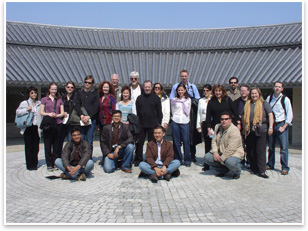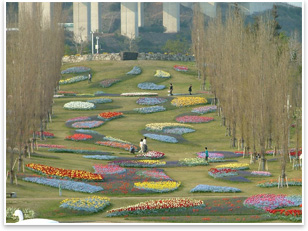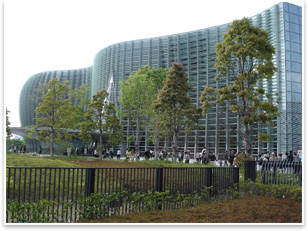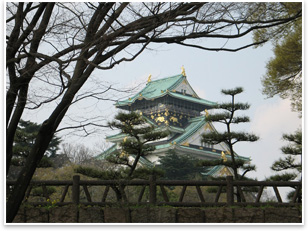Best Practices
WHR Architects’ Japan Design Trip Expands Architecture Awareness
Health-care architecture firm goes to the Far East to learn more than functionality
by Russell Boniface
Associate Editor
 How do you . . . implement an international design trip to help your firm’s younger architects better understand the nuances of architectural design? How do you . . . implement an international design trip to help your firm’s younger architects better understand the nuances of architectural design?
Summary: A team of 21 architects, medical planners, and interior designers from the Houston and Dallas offices of Watkins Hamilton Ross Architects (WHR), one of the country’s leading health-care design firms, embarked on a nine-day design tour of Japan last April. Astute about functionally driven hospital design, the staff’s goal on the trip was to expand its architecture design awareness through international exchange and exploration. The team visited the Japan cities of Tokyo, Osaka, Kyoto, Kobe, and Awaji Island. The Japan tour included Japanese architecture offices, such as Tadao Ando Architects in Tokyo, as well as hospitals, retail, housing, and hotels. The trip also featured many landmarks in each of the five cities.
 Organizing a trip to increase best practices Organizing a trip to increase best practices
In the past few years, WHR has held several design initiatives to counteract concern that its design was at risk because of the intense focus on functionality for health-care facilities and research labs. David Watkins, FAIA, WHR chair and senior principal, last year organized an overnight Dallas/Fort Worth design tour for 21 employees—many of them younger staff and interns—to visit buildings by I.M. Pei, Louis Kahn, Tadao Ando, Renzo Piano, and Philip Johnson. “That was enormously successful,” enthuses Watkins. “Everyone came back energized. Later, we started thinking about what we would do next—how could we ramp it up? Someone jokingly said, ‘how about an international trip?’ We took it seriously. But how could that work?”
Watkins says that he and his staff started to focus on Japan because of its combination of historic and contemporary architecture by both Japanese and international architects. “I put together a budget of what the trip might be,” explains Watkins. “We didn’t think of it as a perk, but there was a little bit of that. We thought it was appropriate to look at cost-sharing. I called in two or three of the interns and said, ‘looks like the trip might cost $4,500 to $4,800 per person. We’re not expecting people to pay that, but what if it’s $1,500—would that be in the realm of reason?’ They all said, ‘absolutely.’ I went to my board and told them we want to take 21 people to Japan, here’s the nine-day itinerary, and how it will work. The board was enthusiastic, and even said that if the young staff can’t afford the $1,500, it would provide monthly payroll deductions to help them pay it over a year.”
A time apart
Watkins explains what he hoped his staff would gain from the trip: “We took this step because we wanted our architects, interior designers, and planners to be able to spend some time together, away from the interruptions of the office, where they could experience world-class architecture and focus their conversations on a wide range of design topics. We also hoped to establish a common bond among many of those in our firm we consider part of our next generation of leadership.”
 Watkins adds it helped to have a personal relationship with 2002 AIA Gold Medal recipient Tadao Ando. “When I was on the AIA Board, I was his sponsor and worked with his office on his Gold Medal presentation, so there’s a special relationship. Tadao told me at that point, ‘if you’re ever in Japan, I’d love to be your host.’ I’m sure he never actually thought I’d show up with 21 people!” Watkins adds it helped to have a personal relationship with 2002 AIA Gold Medal recipient Tadao Ando. “When I was on the AIA Board, I was his sponsor and worked with his office on his Gold Medal presentation, so there’s a special relationship. Tadao told me at that point, ‘if you’re ever in Japan, I’d love to be your host.’ I’m sure he never actually thought I’d show up with 21 people!”
Experiencing Japanese architecture
The WHR team on the nine-day trip included architects, interior designers, and medical planners. Tokyo and Osaka served as the base of the tour, with stops in Kyoto, Kobe, and Awaji Island. Tadao Ando Architects in Tokyo and the Tokyo- and Osaka-based architecture firm Nikken Sekkei hosted the WHR team, which also worked with facilitators, University of Tokyo Professor Yashushi Nagasawa, and Noriko Kashiwagi Aoki of the Kintetsu International travel agency.
The tours included Tokyo’s 54-story Roppongi Hills Mori Tower, the Tokyo Midtown Galleria, the Rokko Housing Projects in Kobe, and Ando’s Awaji Westin Hotel Complex on Awaji Island. Because WHR specializes in health-care design, the group toured several Japanese hospitals, including Tokyo’s Sakakibara Hospital, Osaka's Saiseikai Nakatsu Hospital and Izumisano Hospital, and Kobe’s Kaisei Hospital. “We went on detailed tours of the hospitals and had conversations with health-care architects,” notes Watkins. “It was a great opportunity to talk to Japanese architects on how they approach design and how medical practice is different.”
 The trip also featured architecture landmarks: Tokyo’s National Art Center, Tadao Ando’s 2121 Design Sight in Tokyo’s fashion district, and the Tokyo International Forum; Osaka Castle, Osaka’s Church of the Light (designed by Ando), and the Umeda Sky Building; Kyoto’s Concert Hall and Golden Pavilion; Kobe’s Hyogo Museum; and Awaji Island’s Temple of the Water and Awaji Gardens. Hundreds of photographs, sketches, and diaries catalogued the trip. “We wanted as much documentation as possible,” Watson points out. “We knew everyone would be taking photographs, so we created a place on our firm’s server to download photographs, drawings, and sketches. We also encouraged people to take journals.” The trip also featured architecture landmarks: Tokyo’s National Art Center, Tadao Ando’s 2121 Design Sight in Tokyo’s fashion district, and the Tokyo International Forum; Osaka Castle, Osaka’s Church of the Light (designed by Ando), and the Umeda Sky Building; Kyoto’s Concert Hall and Golden Pavilion; Kobe’s Hyogo Museum; and Awaji Island’s Temple of the Water and Awaji Gardens. Hundreds of photographs, sketches, and diaries catalogued the trip. “We wanted as much documentation as possible,” Watson points out. “We knew everyone would be taking photographs, so we created a place on our firm’s server to download photographs, drawings, and sketches. We also encouraged people to take journals.”
Collective learning experience
Lia Johnson, AIA, associate, WHR Architects, says the most beneficial aspect of the Japan trip was the collective learning experience. “On the surface, I believe we were all aware we were getting to know each other better outside of the office. But there’s something deeply personal about being in an inspiring setting and sharing it with others. In effect, it breeds collaboration because you find yourself surrounded by like-minded people learning about each other's perspectives and perceptions of foreign culture and architecture.
“For example, client projects, which require travel, are usually focused on similar projects or visiting the client and job site. Our view, typically, is somewhat through the lens of our client because we’re concerned with their project's outcome. In contrast, traveling to a foreign place with colleagues and without a project is somewhat agenda-less. To discuss design freely and explore each others’ thoughts, styles, and inclinations is one of the best collaborative tools one could hope for in practice.”
 Watson says Japan was an eye-opening experience for many of them, elevating conversation at the office and resulting in different ways to look at and think about design process. “There’s been a lot of energy and ideas generated because of the trip. It caused us to step back to think about how we organize ourselves and do things conceptually, such as with project delivery, building technology, or the ways buildings handle certain things that we encounter periodically.” Johnson agrees. “Since we’ve returned, there’s been an undeniable fabric or connection among us, which makes our working relationship much richer and more openly creative,” she says. Watson says Japan was an eye-opening experience for many of them, elevating conversation at the office and resulting in different ways to look at and think about design process. “There’s been a lot of energy and ideas generated because of the trip. It caused us to step back to think about how we organize ourselves and do things conceptually, such as with project delivery, building technology, or the ways buildings handle certain things that we encounter periodically.” Johnson agrees. “Since we’ve returned, there’s been an undeniable fabric or connection among us, which makes our working relationship much richer and more openly creative,” she says.
A home run
“Firms talk about initiatives,” declares Watson, “but I think in this case it was clear to our younger employees and interns that we were making an investment in their future—we were putting our money where our mouth was and were serious. I think it’s good to show people you really mean it. Plus, word gets around about employee retention and recruiting.”
Watson hopes to do a trip like Japan every year for WHR, reflecting on the Japan venture as a great experience. “The trip was an opportunity to look very closely at, and get into, buildings that would be hard to see on your own even if you went to Japan by yourself. It was a special group experience to reference back to, a great way for the principals who went on the trip to get to know staff, and something we could afford. It was a home run.” |






